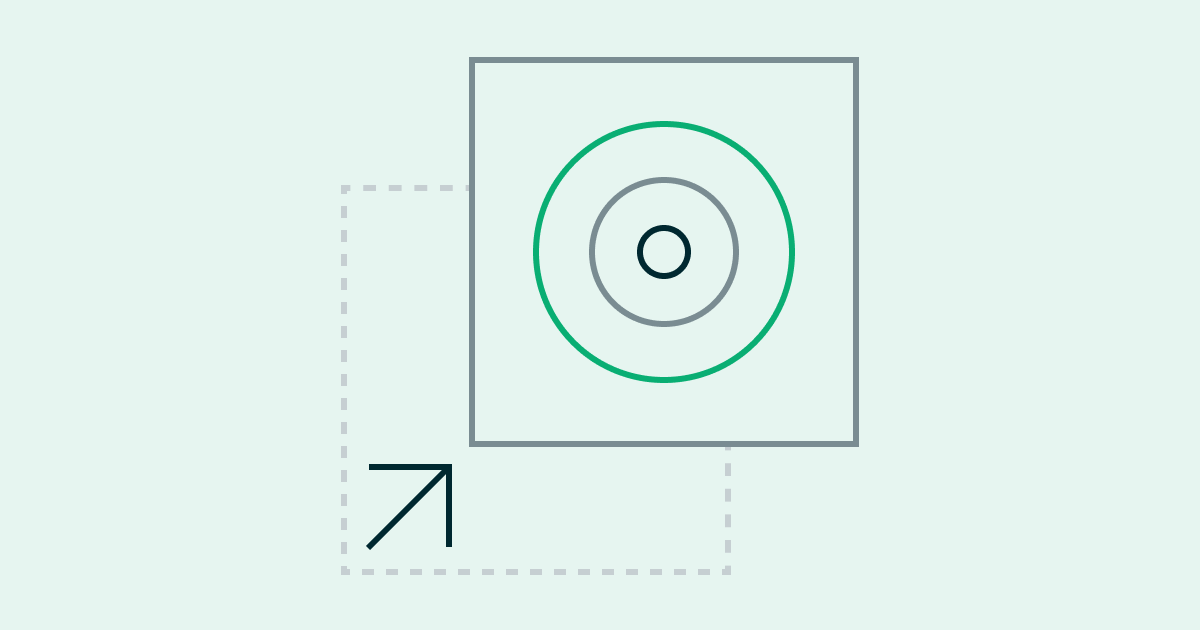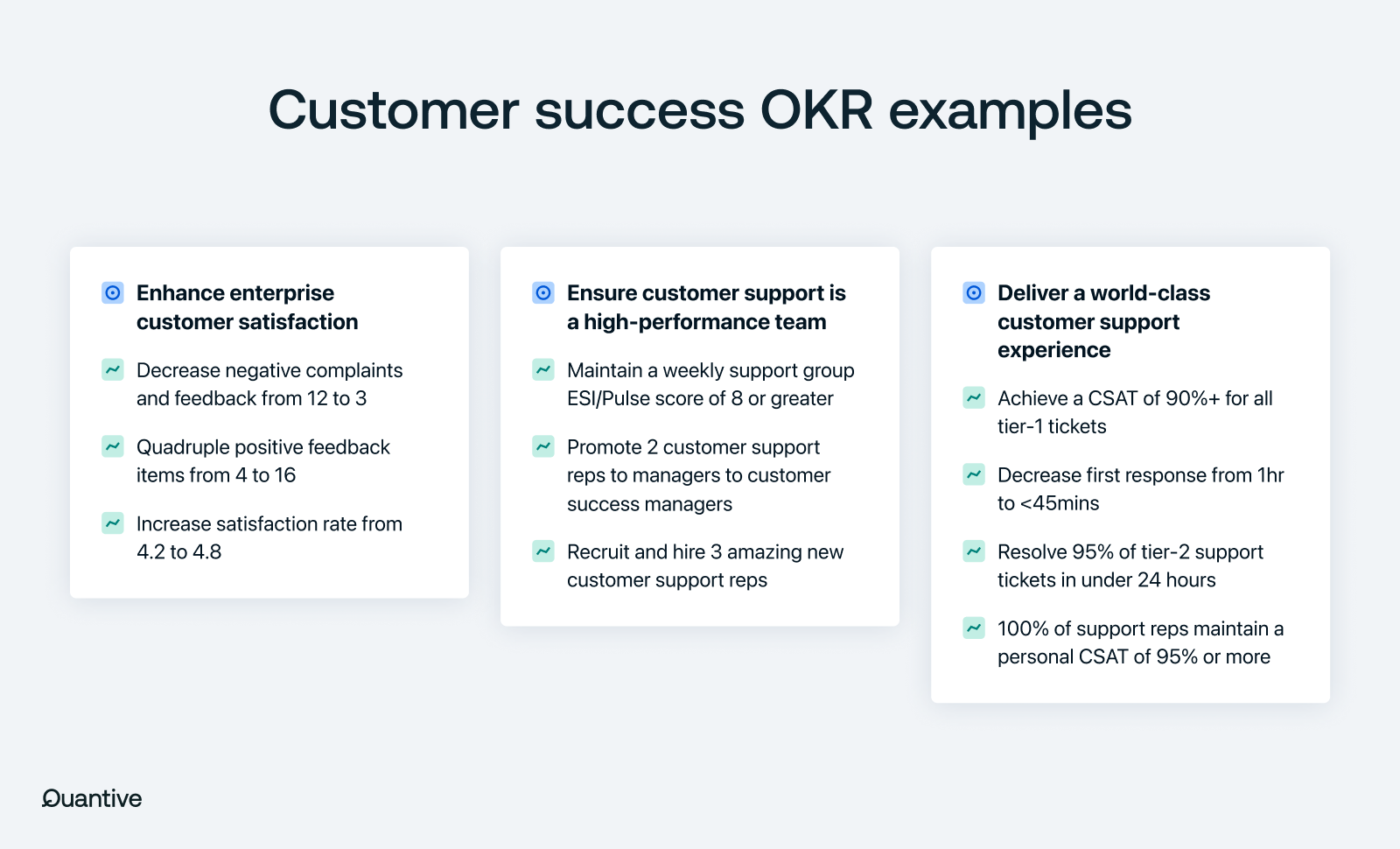Quantive is now part of WorkBoard. Get to know WorkBoard:
Why choose OKRs for customer success teams
OKRs (Objectives and Key Results) help customer service teams prioritize initiatives through collaborative goal setting. Customer success OKRs bring alignment and focus to teams, centered around customer-first strategy and goals.
Learn more about what OKRs are and how to use them

While new customers indicate growth, retaining and supporting customers builds a thriving business. Using OKRs for customer success teams ensures strategically aligned goal setting, so the people using your product or service are equipped to reach their desired outcomes.
As the needs and desires of the customer frequently change, as do the demands of the customer service team. A customer service team's biggest responsibility (and challenge) is adapting to these needs and continuously working to improve customer satisfaction.
Customer success OKRs for teams bring a proactive focus to a customer success team, helping drive outcomes ahead of ever-shifting demands.
Solving challenges with customer success OKRs
Customer success traditionally relies on lagging indicators to measure the health of the organization and the impact of its efforts:
- Retention
- Churn
- NPS
- Expansion
- Growth, etc.
While lagging indicators are critical long-term KPIs, they don’t proactively solve customer success challenges.
Leveraging customer service OKRs for customer service teams improves this process by helping teams prioritize initiatives based on leading indicators, tailored to specific stages of the customer journey.
For example, if churn rate is a red flag indicator, OKRs for customer success build objectives around improving the growth and retention cycles. The supporting key results track progress with critical KPIs, helping customer success teams shift to a proactive strategy.
Setting OKRs for customer success
Customer success OKRs can be developed by looking at the leading indicators in the different stages of customer success (note: these stages serve as an example and are not exclusive or exhaustive):
- Implementation
- Product/service adoption
- Growth
- Expansion/renewal
Choosing a focus is challenging — leadership can use insights from leading indicators to determine where performance is stagnating and which areas need improvement most. From there, team members can execute initiatives to drive the customer success OKR:
- Education (implementation)
- Live support (adoption)
- Inbound requests (growth)
- Follow-ups (retention/renewal)
A well-executed customer success OKR strategy helps customer success teams anticipate the wants and needs of customers instead of reacting to constantly shifting demand. It also helps them make the most out of customer feedback, even negative feedback.
Customer service OKR focus areas
Customer success OKRs can apply to any stage of the customer success journey:
- Product/service adoption
- Customer implementation
- Customer growth
- Customer expansion and renewal
- Customer support
- Team performance
Check out all our customer success OKR examples below.
Customer service OKRs examples
OKRs for customer success: product/service adoption
Customer success OKR example 1
- Objective: Increase product adoption
- Key result 1: 100% of assigned accounts have at least 3 live touches
- Key result 2: Write re-engagement messages for 12 customer lifecycle points
- Key result 3: Improve NPS score to 65+
OKRs for customer success: customer experience
Implementation
- Objective: Increase engagement with new customers
- Key result 1: Triple communication open rate in-product from 6% to 18%
- Key result 2: Triple follow-up meetings booked per week to 24
- Key result 3: Achieve service quality rating of 9.5 or higher
- Key result 4: Reduce response time by 300%
Growth
- Objective: Enhance enterprise customer satisfaction
- Key result 1: Decrease negative complaints and feedback from 12 to 3
- Key result 2: Quadruple positive feedback items from 4 to 16
- Key result 3: Increase satisfaction rate from 4.2 to 4.8
Expansion/renewal
- Objective: Improve end-of-cycle satisfaction strategy
- Key result 1: Collect 1,200 annual satisfaction survey responses
- Key result 2: Schedule 75 phone interviews with best customers
- Key result 3: Schedule 20 phone interviews with churned customers
- Key result 4: Present a Q4 improvement plan
OKRs for customer success: customer support
Customer success OKR example 1
- Objective: Deliver a world-class customer support experience
- Key result 1: Achieve a CSAT of 90%+ for all tier-1 tickets
- Key result 2: Decrease first response from 1hr to <45mins
- Key result 3: Resolve 95% of tier-2 support tickets in under 24 hours
- Key result 4: 100% of support reps maintain a personal CSAT of 95% or more
Customer success OKR example 2
- Objective: Be proactive with customer success
- Key result 1: Implement a customer success platform to increase average health score to above 45
- Key result 2: 100% of red accounts have reviews scheduled
- Key result 3: Net retention rate >112%
OKRs for customer success: team performance
Customer success OKR example 1
- Objective: Ensure customer support is a high-performance team
- Key result 1: Maintain a weekly support group ESI/Pulse score of 8 or greater
- Key result 2: Promote 2 customer support reps to managers to customer success managers
- Key result 3: Recruit and hire 3 amazing new customer support reps

How Quantive simplifies OKRs for customer service teams
Quantive empowers modern organizations to turn their ambitions into reality through strategic agility. It's where strategy, teams, and data come together to drive effective decision-making, streamline execution, and maximize performance.
As your company navigates today’s competitive landscape, you need an Always-On Strategy to continuously bridge the gap between current and desired business outcomes. Quantive brings together the technology, expertise, and passion to transform your strategy and playbooks from a static formulation to a feedback-driven engine for growth.
Whether you’re a fast-growing scale-up, a mid-market business looking to conquer, or a large enterprise looking for innovation, Quantive keeps you ahead – every step of the way. For more information, visit www.quantive.com.





